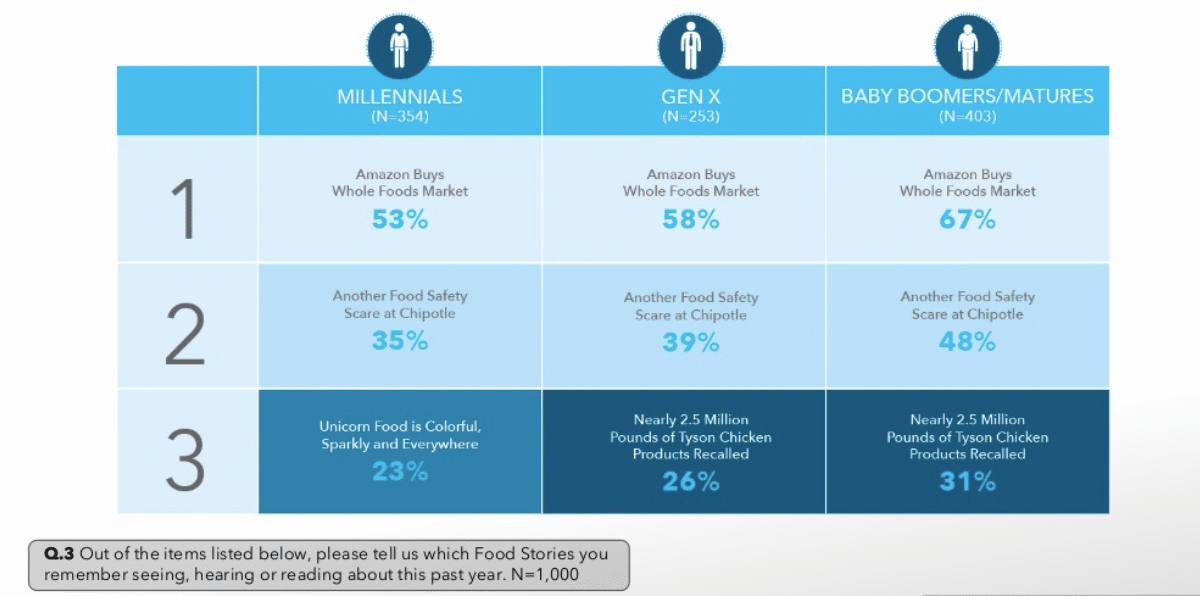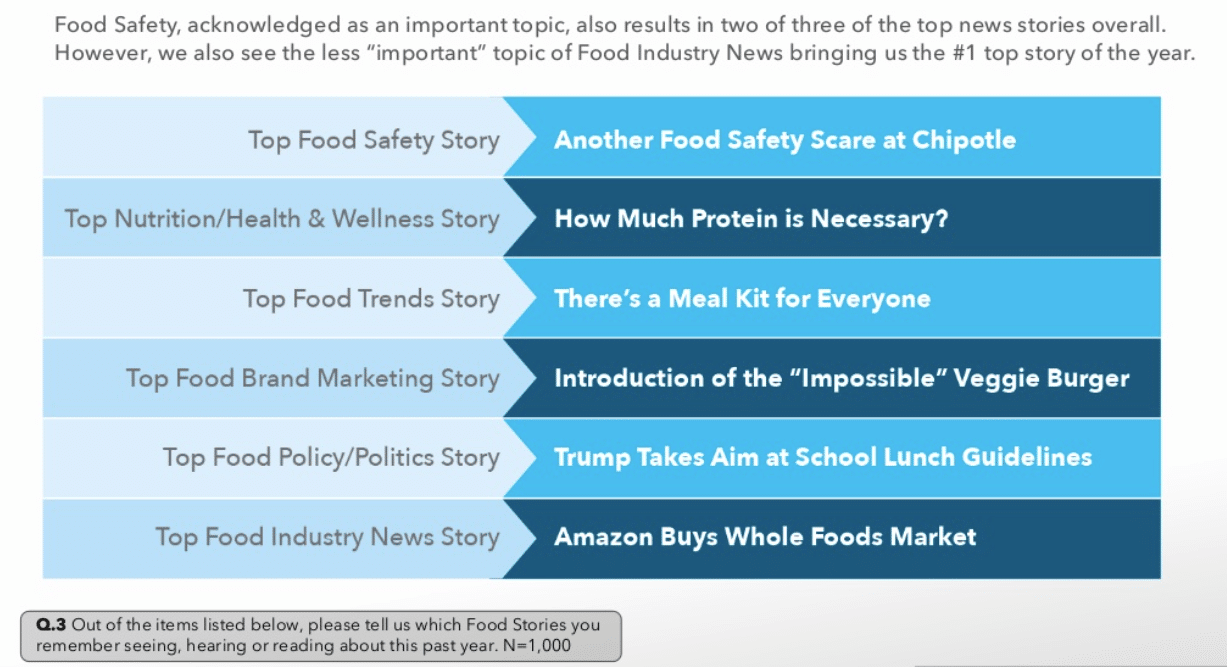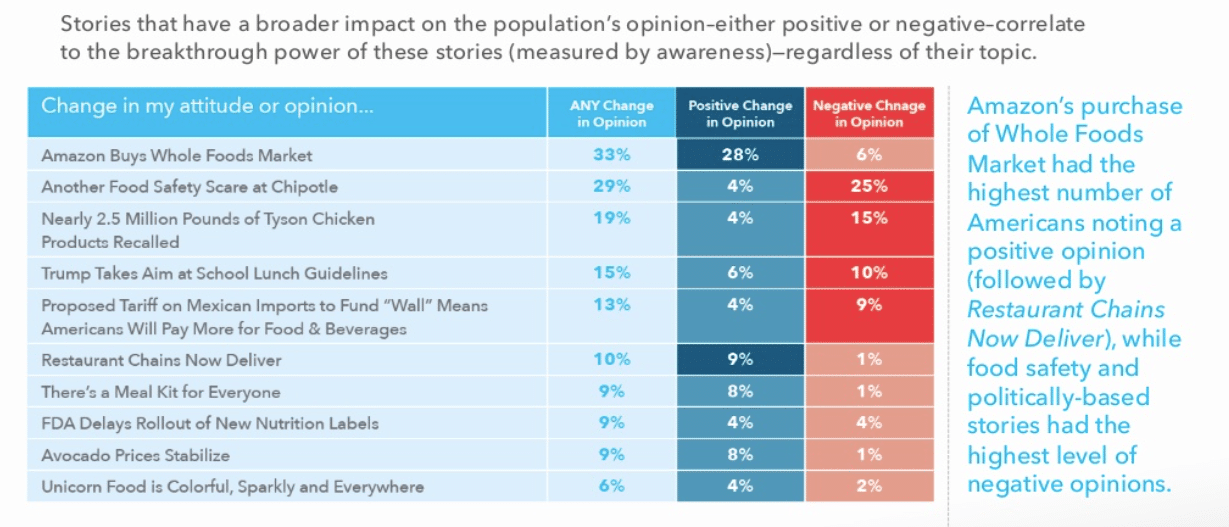“Alexa…acquire Whole Foods Market, please.”
In a year when food topics related to safety and nutrition were most important to Americans, news of Amazon’s acquisition of Whole Foods Market broke through, ranking as 2017’s No. 1 food news story among Millennials, Gen Xers and Baby Boomers/Matures alike, according to the Annual Food News Study from food and beverage marketing communications agency Hunter Public Relations, which reveals the top five most recalled news stories of the past 12 months.
Since 2003, Hunter PR has been commissioning an annual study to identify the top food news stories according to the opinions of Americans. Now in its fifteenth year, this year’s food news study, conducted in partnership with Libran Research & Consulting, also set out to quantify the impact of these stories at every step of the consumer engagement continuum by measuring the influence on consumers’ awareness (are the stories remembered?), consideration (do they change opinions?), intent (do they change behavior?) and advocacy (are they shared with others?).
Amazon*, the world’s largest online retailer, made major headlines on June 16, 2017 when it announced its plans to acquire Whole Foods Market. The e-retail giant, which has dabbled in brick-and-mortar store concepts over the past couple of years, agreed to acquire 460 Whole Foods Market locations in the U.S., Canada and the UK in a 13.7 billion-dollar deal, Amazon’s biggest acquisition to date. On August 28, 2017, the deal was official and Amazon announced that all Whole Foods Market customers would immediately see lower prices across a selection of best-selling products.
What else made the list?
Last year’s top food news story found itself back on this year’s list, occupying 2017’s No. 2 spot: Another Food Safety Scare at Chipotle. Chipotle’s food safety issues made national news late in 2015 and continued in 2016 when norovirus affected more than 200 customers in the Boston area. In 2017, another food-borne illness outbreak affected several Chipotle patrons at an outlet near Washington, D.C., forcing the location to close temporarily and sending the chain’s stock down more than six percent.
Topics of food safety (48 percent) and food nutrition/health and wellness (35 percent) continue to be at the top of the list for most Americans. In addition to Chipotle’s food safety scare taking the No. 2 spot, Nearly 2.5 Million Pounds of Tyson Chicken Products Recalled—due to misbranding and undeclared allergens on ready-to-eat breaded chicken sold to food-service customers in 30 states—came in as the No. 3 food news story of the year.
Though according to the study, topics of food policy and politics are not generally as important to Americans as food safety, three politically-motivated stories claimed top spots this year:
- At No. 4, is the news coverage that ensued after Trump Took Aim at School Lunch Guidelines. In March 2017, the Trump administration challenged Michelle Obama’s agenda to promote healthy school lunches by weakening restrictions on salt and requirements for whole grains. Agriculture Secretary Sonny Perdue announced that school meals would no longer have to adhere to standards championed by the former first lady, granting schools more flexibility to serve foods they choose.
- At No. 6, in January 2017, President Trump Proposed Tariffs on Mexican Imports to Fund the “Wall,” which would mean that Americans would have to pay a 20 percent tax on food and beverages imported from our neighbor to the south. Both before and after the 2016 election, Trump has remained steadfast about building a wall along the Mexican border, and about increasing tariffs on Mexico, as well as other countries. The administration, however, quickly backpedaled, maintaining that the tariff was just one of a few options being considered to fund the construction. News outlets and constituents alike were quick to criticize the proposed tax and the notion that the resulting funds would cover the wall’s costs.
- At No. 8 (tie), President Trump rebuffed yet another one of former first lady Michelle Obama’s health initiative legacies when it was announced in June 2017 that the FDA Would Delay Rollout of New Nutrition Labels, intended to help Americans eat more healthfully. The updated labels, advocated by Mrs. Obama, would have a special line for added sugars and feature calorie content in large, bold text.
Also included in the top 10 food news stories of 2017:
- News around Restaurant Chain Delivery came in at No. 5. With the influx of third-party delivery services, restaurants assume almost no risk in testing out delivery, which means consumers can get much more than just pizza delivered to their door. Steak, anyone?
- Designed to reduce the time and stress of preparing a gourmet, home-cooked meal, Meal Kits snagged the No. 7 spot on the list and came in as the Top Food Trend Story of the Year. Research has shown that the meal-kit industry resonates most with Millennials, who tend to rationalize spending money to save time on shopping and planning, and seek sharable experiences and creations for social media.
- While capturing a unicorn is said to be impossible, it’s no surprise that Unicorn Food captured the No. 8 (tie) spot on this year’s list. The pastel and sparkle trend broke the Internet when Starbucks introduced its limited-time-only “Unicorn Frappuccino.”
- Avocado lovers, rejoice because coming in at No. 10, is the news that Avocado Prices Stabilized. California’s crop size was down in the first half of the year, leading to higher prices. To counter the price incline, growers started planting more avocado trees to keep up with the demand – avocado toast! – and stabilize prices.
The competitive media landscape
This year, more than one-quarter of Americans across all three key age demographics feel that food and nutrition stories are very important, which is comparable to 2016 figures. However, in 2017, only 35 percent say that food and nutrition stories are more important than other types of stories—down from 41 percent in 2016—revealing the competitive nature of today’s media landscape, with politically-charged stories dominating the news cycle.
About those Millennials…
Amazon’s acquisition of Whole Foods Market and Chipotle’s new food safety scare were ranked as the No. 1 and No. 2 stories, respectively, across Millennials, Gen Xers and Baby Boomers/Matures. When it came to the story that occupied the No. 3 spot, Gen Xers and Baby Boomers/Matures both agreed on Tyson’s chicken recall, while Millennials ranked the emergence of unicorn food as the third most memorable food story of 2017. The study also revealed that Millennials are more often moved to change as a result of these stories and report higher levels of changed opinions across many stories, even those outside of the top three, including Restaurant Chains Now Deliver and Avocado Prices Stabilize.
Impact of food news on consideration, intent and advocacy
Stories that have a broader impact on the population’s opinion—either positive or negative—correlate to the breakthrough power of these stories, measured by awareness, regardless of their topic. Unsurprisingly, the top stories of 2017 are also delivering the top changes of opinion among consumers. News of Amazon’s Whole Foods Market purchase—this year’s No. 1 story—had the highest number of Americans, especially Millennials, noting a change of opinion, trailed closely by the food safety scare at Chipotle and Tyson recall—the No. 2 and No. 3 stories, respectively.
Similarly, the top stories of the year based on awareness are also those most likely to drive behavior changes among all consumers polled. But when looking at behavior changes, specifically among those aware of a particular news story, several nutrition and trend-related stories broke into the top 10. The Top Nutrition Story of the Year and No. 13 overall, How Much Protein is Necessary?, rose to the top at 44 percent, and Veggies Are Becoming the Star of Your Meal impacted the behavior of 41 percent of those aware. Trend-related news stories, The Rise in Korean Flavors (44 percent), The Fermented Food Trend (34 percent), and Cheers to Frosé! (30 percent) all had a substantial impact, reinforcing the connection between awareness and behavior.
The most noted specific food behavior changes occurring this year by Americans is paying more attention to food labels, where almost one-third of Americans admit to this change. Secondary specific behavior changes include educating oneself more on food (24 percent), paying more attention to food’s impact on health (24 percent), as well as to food safety (24 percent) and ingredients (23 percent). While all age groups are most likely to be paying more attention to food labels, compared to Gen Xers and Baby Boomers/Matures, Millennials are more likely to try new foods and flavors and change how they prepare food as a result of the top food stories. Millennials are also more likely to change their diet and how they shop and pay more attention to their impact on the environment.
In recognition of the power of social media to fuel news sharing, for the first time this year, the Hunter Public Relations Food News Study went a step further along the consumer engagement continuum to examine advocacy and the “share-ability” of food related news. This year’s top stories appear to have more “water cooler” sharing potential, meaning that Americans are more open to talking about these stories with friends, family or coworkers. Those stories that broke into the top 10 for social sharing of the article itself often offer a “teachable moment,” such as How Much Protein is Necessary? and Warriors Against Food Waste, as well as those with a touch of shock value, including Insect-Based Foods Rise in Popularity and The Dark Side of Food: Activated Charcoal.
New media leads for food information
Beginning in 2012, the Hunter Public Relations Food News Study expanded to delve more deeply into where and how consumers are accessing information about food, recipes and nutrition. For the first time this year, social media has become the No. 1 source for recipes for all consumers, taking over websites as the go-to source. Millennials lead the shift, with 40 percent reporting that they have found recipe inspiration on Facebook, as well as Pinterest (38 percent) and Instagram (35 percent). Surprisingly, nearly 15 percent report that they have found recipe inspiration on Snapchat. For many consumers, it seems, there is not a single source for food news, but rather most find their primary nutrition news on websites (39 percent), search for recipes on social media (51 percent) and learn about general food news on television (42 percent). For Hispanic consumers, though, social media is the number one source for all food news including recipes (60 percent), nutrition (48 percent) and general food news (51 percent).
To summarize, the top food stories of 2017 according to the Hunter Public Relations 15th Annual Food News Study are as follows:
- Amazon Acquires Whole Foods Market
- Another Food Safety Scare at Chipotle
- Nearly 2.5 Million Pounds of Tyson Chicken Products Recalled
- Trump Takes Aim at School Lunch Guidelines
- Restaurant Chains Now Deliver
- Proposed Tariff on Mexican Imports to Fund “Wall” Means Americans Will Pay More for Food & Beverages
- There’s a Meal Kit for Everyone
- (TIE) Unicorn Food is Colorful, Sparkly and Everywhere
- (TIE) FDA Delays Rollout of New Nutrition Labels
- Avocado Prices Stabilize
For additional information about the Hunter PR 2017 Food News Study, including detailed study results, visit http://www.hunterpr.com/our-pov/foodstudy.html.
The survey was implemented Oct. 24 to Oct. 28, 2017, covering the 12-month period from November 2016 through October 2017. Libran Research surveyed 1,000 Americans ages 18 years and older via an email invitation and online survey. The respondent sample was balanced to the U.S. population on key demographics. Results of any sample are subject to sampling variation. For the interviews conducted in this particular study, the chances are 95 in 100 that a survey result does not vary, plus or minus, by more than 3.1 percentage points.
*As of May 1, 2017, Hunter PR is an Agency of Record for select Amazon U.S. retail businesses. Hunter PR was not involved in the dissemination of any information surrounding the acquisition of Whole Foods Market.






